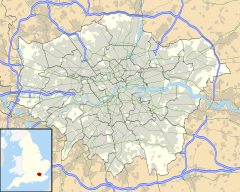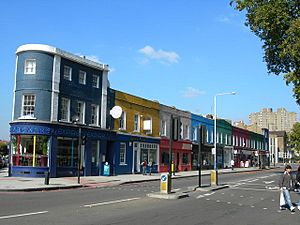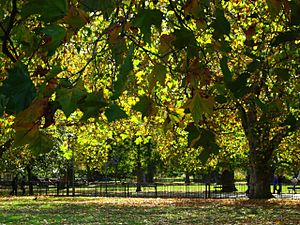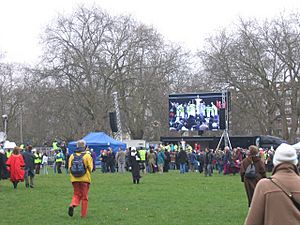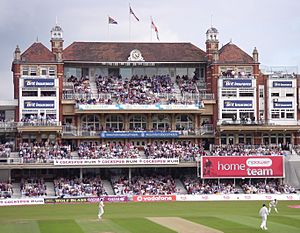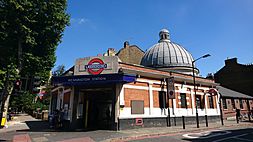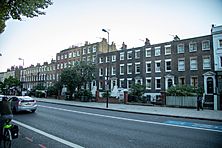Kennington facts for kids
Quick facts for kids Kennington |
|
|---|---|
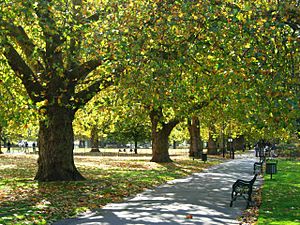 Kennington Park |
|
| Population | 15,106 (Oval ward 2011 Census) |
| OS grid reference | TQ305775 |
| • Charing Cross | 1.4 mi (2.3 km) N |
| London borough | |
| Ceremonial county | Greater London |
| Region | |
| Country | England |
| Sovereign state | United Kingdom |
| Post town | LONDON |
| Postcode district | SE11 |
| Dialling code | 020 |
| Police | Metropolitan |
| Fire | London |
| Ambulance | London |
| EU Parliament | London |
| UK Parliament |
|
| London Assembly |
|
Kennington is a lively area in south London, England. It is mostly in the London Borough of Lambeth. It also borders the London Borough of Southwark. This border has been there since the early Middle Ages. Kennington is about 1.4 miles (2.3 km) south of Charing Cross in Inner London. It is known as a local hub in the London Plan.
Long ago, Kennington was a royal estate. It was part of the St Mary, Lambeth parish in the county of Surrey. From 1853, it was the main office for the parish. Being close to central London helped it grow into a place where many people lived. In 1855, it became part of London.
Kennington is home to three famous London spots. These are the Oval cricket ground, the Imperial War Museum, and Kennington Park. In 2011, about 15,106 people lived here. Kennington also has its own police station.
Contents
Kennington's Past: A Royal History
What's in a Name?
The name Kennington comes from old English words. It might mean 'farm or estate belonging to a man named Cēna'. Another idea is that it means "place of the King" or "town of the King."
Early Days and Royal Connections
Ancient mounds and other features suggest Kennington was once a special meeting place. In 1086, the Domesday Book listed it as Chenintune. It was owned by Teodric the Goldsmith. The area had farms and meadows. It brought in £3 each year.
The River Effra separated Kennington from the area of Vauxhall. Another smaller river, the River Neckinger, ran along the northern part of Kennington. Both rivers now flow underground.
Many English kings and queens visited Kennington.
- Harthacnut, King of Denmark and England, died here in 1041.
- Harold Godwinson became king here in 1066.
- King Henry III held his court here in 1231.
- In 1232, the Parliament met in Kennington.
Edward III gave Kennington to his son, Edward, the Black Prince, in 1337. The prince built a large royal palace here. It was near Kennington Lane. In 1376, John of Gaunt came to Kennington to escape angry Londoners. Geoffrey Chaucer, a famous writer, worked here in 1389. He was paid 2 shillings.
Kings Henry IV and Henry VI sometimes lived in Kennington. Henry VII stayed here before his coronation. Catherine of Aragon visited Kennington Palace in 1501. In 1531, King Henry VIII ordered most of the palace to be taken down. Its stones were used to build the Palace of Whitehall.
Today, the area is still owned by the King's eldest son. This is currently Prince William, the Duke of Cornwall. The Duchy of Cornwall still owns many properties in Kennington.
Growing Up: The 18th Century
The 1700s saw Kennington grow a lot. At first, it was a small village on the roads leading into London. There was a common area where public executions took place. In 1746, nine people involved in the Jacobite Rising were executed there.
In 1750, Westminster Bridge was built. This made it easier to get to London. In 1751, Kennington Road was built. It connected Kennington Common (now Kennington Park) to Westminster Bridge Road.
By the 1770s, Kennington was changing into the area we know today. Houses were built along Kennington Road. Cleaver Square was created in 1788. Architect Michael Searles built houses along Kennington Park Road in the 1790s. The last person to be executed at Kennington Common was a fraudster named Badger in 1799.
Becoming Modern: The 19th Century
By the early 1800s, Kennington's streets looked much like they do now. It was a fancy suburb with large houses.
Kennington Common used to be a messy place. In 1824, St. Mark's Church was built where the gallows once stood. This church was one of four "Waterloo Churches" in south London. In 1852, the Common was turned into the first public park in south London.
More houses were built in the early 1800s. Walcot Square and St Mary's Gardens were created in the 1830s. Imperial Court was built in 1836 for a school.
The Oval cricket ground was rented to Surrey County Cricket Club in 1845. The gas towers next to it were built in 1853.
Kennington became very crowded by 1859. The church of St John the Divine, Kennington, known as "the most magnificent church in South London," was built between 1871 and 1874. It was designed by George Edmund Street.
The Durning Library at Kennington Cross was built in 1889. It was a gift to the people of Kennington. A public restroom built in 1898 is now an arts venue. It might have been used by a young Charlie Chaplin. He also stayed at the old Lambeth Workhouse, now the Cinema Museum.
Kennington tube station opened in 1890. It is on the border of Kennington and Newington.
In 1898–99, a map showed that Kennington had a mix of rich and poor people. Some streets were "Well-to-do," while others were "Poor." This showed a big difference in wealth.
Recent Times: The 20th and 21st Centuries
In the 1900s, Kennington changed. At first, it saw a decline. Middle-class families moved to outer London. Large houses were split into smaller flats, offering cheap places to live.
In 1908, Kennington stopped being the main administrative center for Lambeth. A new Town Hall was built in Brixton. The old Town Hall is now used by the Countryside Alliance.
From 1915, the Duchy of Cornwall started a big project to rebuild parts of the area. New streets and buildings were designed in a Neo-Georgian style.
Lambeth Hospital was created in 1922 from an old workhouse. It was one of London's largest hospitals. It closed in 1976.
Kennington station was rebuilt in 1925. This was for the Northern line extension. Kennington became a busy transport hub.
The Belgrave Hospital for Children was finished in 1926. It was later turned into apartments. In the 1930s, the Duchy of Cornwall continued to build new homes.
During World War II, on October 15, 1940, a bomb hit the air-raid shelter under Kennington Park. Many people died.
St. Agnes Place was a street of old houses. In the late 1960s, people started living in empty houses there without permission. It became London's longest-running squat. The houses were eventually torn down in 2007.
In 1968, Lambeth Council made much of Kennington a Conservation Area. This means its old buildings and open spaces are protected. Cleaver Square's garden was restored in the late 1900s. People now play pétanque there in the summer.
In recent years, Kennington has become more popular. This is because of its good location and transport links to the West End and the City of London. Many old houses have been turned back into family homes. However, there are still many council-owned homes. This mix of housing shows the different types of people living in Kennington.
Kennington's Location
Kennington does not have official borders anymore. But its old boundaries are still clear. The main postcode for Kennington is SE11. Some parts are also in SE17, SE1, SW8, and SW9. The area around Kennington Oval stretches towards Vauxhall.
 |
South Bank | North Lambeth and Waterloo | Elephant and Castle and Old Kent Road |  |
| Vauxhall | Camberwell and Walworth | |||
| South Lambeth and Nine Elms | Stockwell and Clapham | Brixton |
Nearest places:
- Vauxhall
- Waterloo
- Walworth
- Newington, also known as Elephant and Castle
- Stockwell
- Camberwell
- Brixton
- Lambeth North
Life in Kennington
Kennington is a diverse area with people from many backgrounds. It attracts young, successful people.
Kennington is close to the Houses of Parliament. This means many politicians and government workers live here. It is sometimes called "the politicians' area."
Kennington Road and Kennington Lane are the main shopping areas. They have local shops, restaurants, cafes, and a Post Office. There is also a Tesco supermarket.
The area has many pubs and some bars. There is one nightclub, the South London Pacific. Kennington has two theatres: the White Bear Theatre and the Oval House Theatre. The Kennington Association is a local group that helps the community. The Friends of Kennington Park work to improve the park. Kennington is also home to The Cinema Museum, a popular place for movies and learning about film history.
A weekly farmers' market is held every Saturday at St. Mark's Church.
The Beefeater Gin distillery, which makes gin, is in Kennington. The City and Guilds of London Art School, a very old art college, has been here since 1879.
Kennington in Books and Movies
Kennington has been featured in many stories and films:
- In 1915, Of Human Bondage by W. Somerset Maugham was set here.
- In 1945, London Belongs to Me by Norman Collins used Kennington as its main setting.
- Scenes from the 1949 film Passport to Pimlico were filmed here.
- The 1990 film The Krays was filmed in Kennington.
- A pub in Kennington was used in the 2000 film Snatch.
- The 2001 book London Boulevard and its 2010 film adaptation feature Kennington.
- In the 2008 film Traitor, a character exits Kennington tube station.
- The 2010 film The Ghost Writer mentions a character living in Kennington.
- Scenes from the 2011 film The Iron Lady were filmed here.
- The 2011 film Attack the Block is set in Kennington.
- The 2014 film Kingsman: The Secret Service filmed scenes at The Black Prince pub.
Famous Places in Kennington
Kennington Park
Kennington Park and St Mark's Churchyard are built on what was once Kennington Common. The park was designed by James Pennethorne. It was once a Royal Park. Now, Lambeth Council manages it.
Historically, the Park was a place for executions and public meetings. People gathered here for political and religious talks. It was also used for sports.
In the 1730s, Methodist leaders John Wesley and George Whitefield preached to thousands here. In 1746, nine leaders of the Jacobite rebellion were executed on the Common. The Chartists held their biggest protest here in 1848. A group called "The Gymnastic Society" played football here in the 1700s. They are sometimes called the world's first football club.
Today, Kennington Park is still a place for protests before marches to Parliament. In 2011, it was a starting point for a march against government cuts. In 2012, it hosted a student rally against higher tuition fees.
The Oval Cricket Ground
The Oval, also known as "The Kia Oval," is the home of Surrey County Cricket Club. It hosts the final Test match of the English summer. The Oval was the first ground in the UK to host Test cricket. It also held the first international football match in 1870 and the first FA Cup final in 1872. The Oval is called "the Grand Old Lady" because of its important role in sports history.
Before it was a cricket ground, this area was used to grow cabbages!
Stane Street: An Ancient Road
Kennington Park Road and Clapham Road are very straight. This is because they follow an old Roman road called Stane Street. This road went from the Roman London Bridge all the way to Chichester. Another Roman road branched off near Kennington Road. It went through what is now Kennington Park.
Getting Around Kennington
Tube Stations
Kennington has several London Underground stations:
- Kennington tube station is on the Northern line. It connects to Central London, the City of London, and North London. Some trains end here, while others go south to Morden.
- Oval tube station is also on the Northern line.
- Other nearby stations include Lambeth North on the Bakerloo line and Vauxhall on the Victoria line. Vauxhall also has National Rail trains to Waterloo.
The Northern line is being extended from Kennington to new stations at Nine Elms and Battersea Power Station. This extension is set to open in September 2021.
Buses
Many London Buses routes serve Kennington. Some routes run 24 hours a day. Night buses also serve the area.
Roads
Several main roads pass through Kennington:
- A3 (Kennington Park Road): Goes northeast to Elephant and Castle, London Bridge, and the City of London. It goes southwest to Stockwell, Clapham, and Portsmouth.
- A23 (Kennington Road/Brixton Road): Goes north to Lambeth and Westminster. It goes south to Brixton and Gatwick Airport.
- A202 (Kennington Oval/Camberwell New Road): Goes northwest to Vauxhall and Victoria. It goes southeast to Camberwell and Peckham.
- A3204 (Kennington Lane): Goes northeast to the A3 and Elephant & Castle. It goes southeast to Vauxhall.
Cycling
Kennington has several cycle routes:
- Cycle Superhighway 5 (CS5): From Kennington Oval to Pimlico. It has a special path just for bikes.
- Cycle Superhighway 7 (CS7): Runs along the A3/Kennington Park Road. It goes north to Southwark Bridge and south to Colliers Wood.
- Quietway 5 (Q5): A bike route on quiet streets from Norbury to Waterloo.
- Camberwell New Road: Has bike lanes on both sides.
Santander Cycles, London's bike-sharing system, is also available in Kennington.
Schools in Kennington
There are seven primary schools in Kennington:
- Archbishop Sumner School (Church of England)
- Henry Fawcett Primary School
- St. Anne's Primary School (Roman Catholic)
- St. Mark's Primary School (Church of England)
- Vauxhall Primary School
- Walnut Tree Walk Primary School
- Keyworth Primary School
There are two secondary schools:
- Archbishop Tenison's School (for boys and girls aged 11-19)
- Lilian Baylis Technology School (for boys and girls aged 11–16)
Famous People from Kennington
Many notable people have lived in Kennington:
- William Hogarth, a famous artist, lived here in the early 1700s.
- William Blake, an artist and poet, lived at Hercules Road from 1790 to 1800.
- Eliza Cook, a writer and poet, lived here in the early 1800s.
- William Bligh, Captain of the Bounty, lived near the Imperial War Museum.
- Sir William Chandler Roberts-Austen, a metallurgist, was born here in 1843.
- William Booth, who started The Salvation Army, worked here in 1849.
- E. Nesbit, the children's author who wrote The Railway Children, was born here in 1858.
- Vincent van Gogh, the famous artist, lived on Kennington Road in the 1870s.
- Bernard Montgomery, a famous British Army officer, was born here in 1887.
- Charlie Chaplin, the silent film star, grew up in Kennington.
- Bob Marley, the Jamaican musician, sometimes stayed at St. Agnes Place in the 1970s.
- James Callaghan, a former Prime Minister, lived on Kennington Park Road.
- Many politicians, including David Laws, Lembit Öpik, Kevin Spacey, Jack Straw, Alistair Darling, and Hazel Blears, have lived in Kennington.
- Musicians like Florence Welch (from Florence and the Machine) and David Ball (from Soft Cell) have lived here.
- Footballer Jadon Sancho and rappers like Loski and Blanco are also from Kennington.
Images for kids
-
Plaque at St Mark's Church, Kennington in 2022
See also
 In Spanish: Kennington para niños
In Spanish: Kennington para niños


